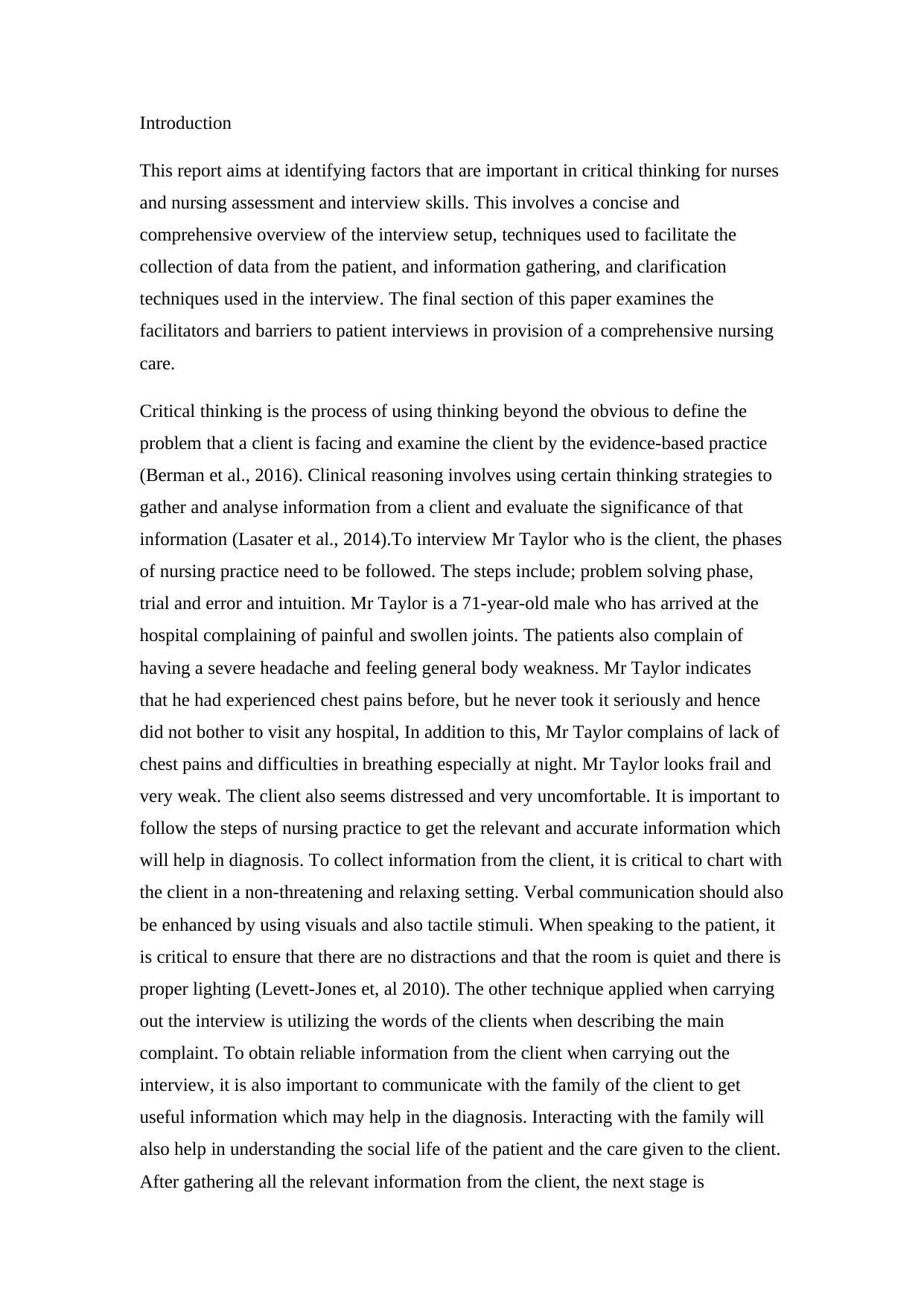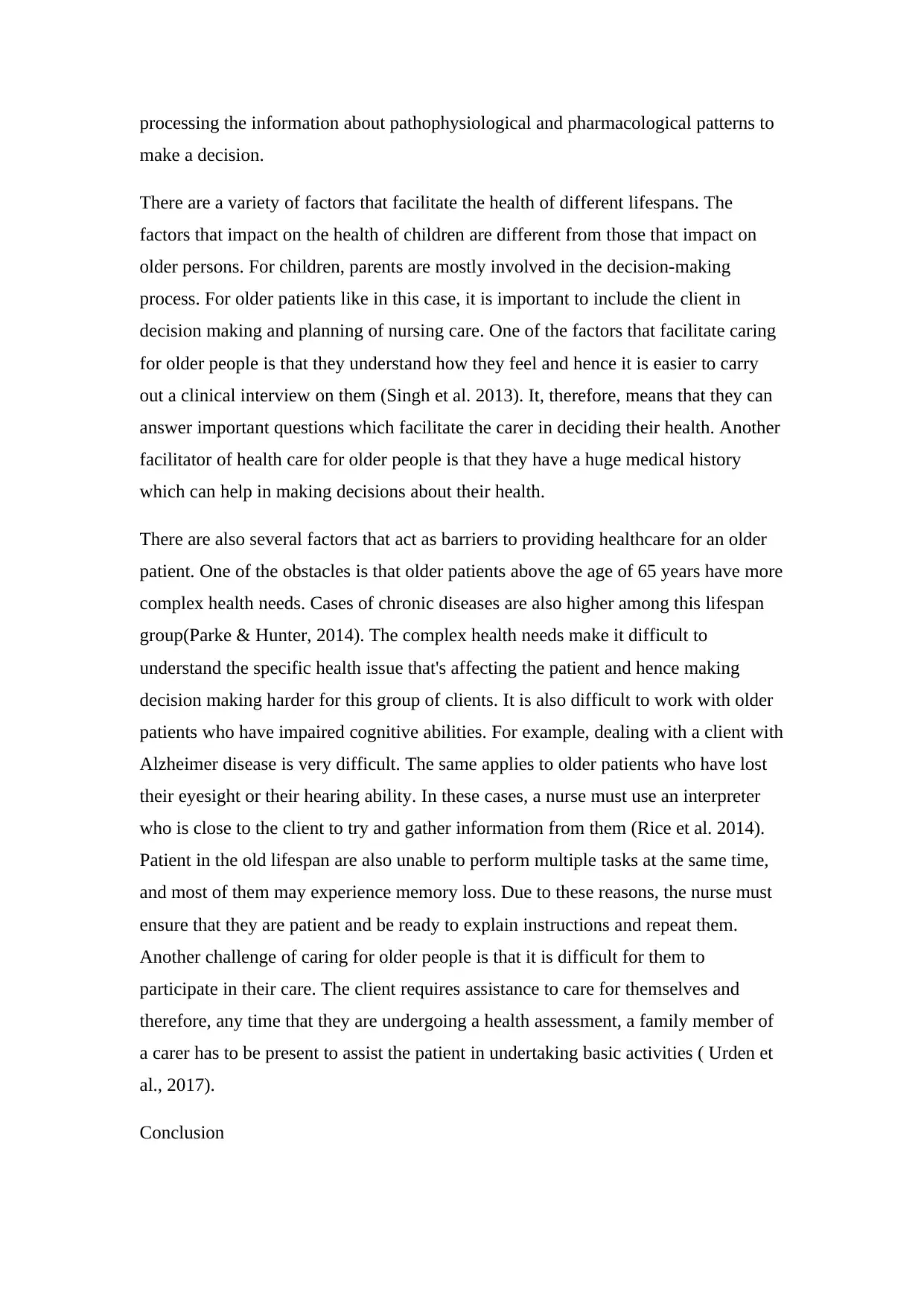Nursing Report on Critical Thinking, Assessment, and Interview Skills
VerifiedAdded on 2023/01/10
|5
|1373
|55
Report
AI Summary
This report provides a detailed analysis of critical thinking, nursing assessment, and interview skills. It begins with an introduction to critical thinking and clinical reasoning, emphasizing their importance in patient care. The report outlines the steps involved in interviewing a patient, including creating a comfortable environment, utilizing effective communication techniques, and gathering relevant information. It uses the case of Mr. Taylor, a 71-year-old patient, to illustrate the application of these techniques. Furthermore, the report discusses facilitators and barriers to patient interviews, particularly in the context of older adults, highlighting factors like complex health needs, cognitive impairments, and the importance of family involvement. The conclusion reiterates the significance of critical thinking and clinical reasoning in nursing practice and their impact on patient outcomes, especially for elderly clients. References to support the analysis are also included in the report.

Name of student:
Registration number:
Unit Title:
Unit Code:
Name of supervisor:
Date due:
Registration number:
Unit Title:
Unit Code:
Name of supervisor:
Date due:
Paraphrase This Document
Need a fresh take? Get an instant paraphrase of this document with our AI Paraphraser

Introduction
This report aims at identifying factors that are important in critical thinking for nurses
and nursing assessment and interview skills. This involves a concise and
comprehensive overview of the interview setup, techniques used to facilitate the
collection of data from the patient, and information gathering, and clarification
techniques used in the interview. The final section of this paper examines the
facilitators and barriers to patient interviews in provision of a comprehensive nursing
care.
Critical thinking is the process of using thinking beyond the obvious to define the
problem that a client is facing and examine the client by the evidence-based practice
(Berman et al., 2016). Clinical reasoning involves using certain thinking strategies to
gather and analyse information from a client and evaluate the significance of that
information (Lasater et al., 2014).To interview Mr Taylor who is the client, the phases
of nursing practice need to be followed. The steps include; problem solving phase,
trial and error and intuition. Mr Taylor is a 71-year-old male who has arrived at the
hospital complaining of painful and swollen joints. The patients also complain of
having a severe headache and feeling general body weakness. Mr Taylor indicates
that he had experienced chest pains before, but he never took it seriously and hence
did not bother to visit any hospital, In addition to this, Mr Taylor complains of lack of
chest pains and difficulties in breathing especially at night. Mr Taylor looks frail and
very weak. The client also seems distressed and very uncomfortable. It is important to
follow the steps of nursing practice to get the relevant and accurate information which
will help in diagnosis. To collect information from the client, it is critical to chart with
the client in a non-threatening and relaxing setting. Verbal communication should also
be enhanced by using visuals and also tactile stimuli. When speaking to the patient, it
is critical to ensure that there are no distractions and that the room is quiet and there is
proper lighting (Levett-Jones et, al 2010). The other technique applied when carrying
out the interview is utilizing the words of the clients when describing the main
complaint. To obtain reliable information from the client when carrying out the
interview, it is also important to communicate with the family of the client to get
useful information which may help in the diagnosis. Interacting with the family will
also help in understanding the social life of the patient and the care given to the client.
After gathering all the relevant information from the client, the next stage is
This report aims at identifying factors that are important in critical thinking for nurses
and nursing assessment and interview skills. This involves a concise and
comprehensive overview of the interview setup, techniques used to facilitate the
collection of data from the patient, and information gathering, and clarification
techniques used in the interview. The final section of this paper examines the
facilitators and barriers to patient interviews in provision of a comprehensive nursing
care.
Critical thinking is the process of using thinking beyond the obvious to define the
problem that a client is facing and examine the client by the evidence-based practice
(Berman et al., 2016). Clinical reasoning involves using certain thinking strategies to
gather and analyse information from a client and evaluate the significance of that
information (Lasater et al., 2014).To interview Mr Taylor who is the client, the phases
of nursing practice need to be followed. The steps include; problem solving phase,
trial and error and intuition. Mr Taylor is a 71-year-old male who has arrived at the
hospital complaining of painful and swollen joints. The patients also complain of
having a severe headache and feeling general body weakness. Mr Taylor indicates
that he had experienced chest pains before, but he never took it seriously and hence
did not bother to visit any hospital, In addition to this, Mr Taylor complains of lack of
chest pains and difficulties in breathing especially at night. Mr Taylor looks frail and
very weak. The client also seems distressed and very uncomfortable. It is important to
follow the steps of nursing practice to get the relevant and accurate information which
will help in diagnosis. To collect information from the client, it is critical to chart with
the client in a non-threatening and relaxing setting. Verbal communication should also
be enhanced by using visuals and also tactile stimuli. When speaking to the patient, it
is critical to ensure that there are no distractions and that the room is quiet and there is
proper lighting (Levett-Jones et, al 2010). The other technique applied when carrying
out the interview is utilizing the words of the clients when describing the main
complaint. To obtain reliable information from the client when carrying out the
interview, it is also important to communicate with the family of the client to get
useful information which may help in the diagnosis. Interacting with the family will
also help in understanding the social life of the patient and the care given to the client.
After gathering all the relevant information from the client, the next stage is

processing the information about pathophysiological and pharmacological patterns to
make a decision.
There are a variety of factors that facilitate the health of different lifespans. The
factors that impact on the health of children are different from those that impact on
older persons. For children, parents are mostly involved in the decision-making
process. For older patients like in this case, it is important to include the client in
decision making and planning of nursing care. One of the factors that facilitate caring
for older people is that they understand how they feel and hence it is easier to carry
out a clinical interview on them (Singh et al. 2013). It, therefore, means that they can
answer important questions which facilitate the carer in deciding their health. Another
facilitator of health care for older people is that they have a huge medical history
which can help in making decisions about their health.
There are also several factors that act as barriers to providing healthcare for an older
patient. One of the obstacles is that older patients above the age of 65 years have more
complex health needs. Cases of chronic diseases are also higher among this lifespan
group(Parke & Hunter, 2014). The complex health needs make it difficult to
understand the specific health issue that's affecting the patient and hence making
decision making harder for this group of clients. It is also difficult to work with older
patients who have impaired cognitive abilities. For example, dealing with a client with
Alzheimer disease is very difficult. The same applies to older patients who have lost
their eyesight or their hearing ability. In these cases, a nurse must use an interpreter
who is close to the client to try and gather information from them (Rice et al. 2014).
Patient in the old lifespan are also unable to perform multiple tasks at the same time,
and most of them may experience memory loss. Due to these reasons, the nurse must
ensure that they are patient and be ready to explain instructions and repeat them.
Another challenge of caring for older people is that it is difficult for them to
participate in their care. The client requires assistance to care for themselves and
therefore, any time that they are undergoing a health assessment, a family member of
a carer has to be present to assist the patient in undertaking basic activities ( Urden et
al., 2017).
Conclusion
make a decision.
There are a variety of factors that facilitate the health of different lifespans. The
factors that impact on the health of children are different from those that impact on
older persons. For children, parents are mostly involved in the decision-making
process. For older patients like in this case, it is important to include the client in
decision making and planning of nursing care. One of the factors that facilitate caring
for older people is that they understand how they feel and hence it is easier to carry
out a clinical interview on them (Singh et al. 2013). It, therefore, means that they can
answer important questions which facilitate the carer in deciding their health. Another
facilitator of health care for older people is that they have a huge medical history
which can help in making decisions about their health.
There are also several factors that act as barriers to providing healthcare for an older
patient. One of the obstacles is that older patients above the age of 65 years have more
complex health needs. Cases of chronic diseases are also higher among this lifespan
group(Parke & Hunter, 2014). The complex health needs make it difficult to
understand the specific health issue that's affecting the patient and hence making
decision making harder for this group of clients. It is also difficult to work with older
patients who have impaired cognitive abilities. For example, dealing with a client with
Alzheimer disease is very difficult. The same applies to older patients who have lost
their eyesight or their hearing ability. In these cases, a nurse must use an interpreter
who is close to the client to try and gather information from them (Rice et al. 2014).
Patient in the old lifespan are also unable to perform multiple tasks at the same time,
and most of them may experience memory loss. Due to these reasons, the nurse must
ensure that they are patient and be ready to explain instructions and repeat them.
Another challenge of caring for older people is that it is difficult for them to
participate in their care. The client requires assistance to care for themselves and
therefore, any time that they are undergoing a health assessment, a family member of
a carer has to be present to assist the patient in undertaking basic activities ( Urden et
al., 2017).
Conclusion
⊘ This is a preview!⊘
Do you want full access?
Subscribe today to unlock all pages.

Trusted by 1+ million students worldwide

Critical thinking and clinical reasoning skills are very crucial in understanding health
issue of a patient. It is important that nurses understand and practice critical thinking
and clinical reasoning when dealing with both children, adolescents as well as older
clients. Use of the skills when carrying out clinical interviews helps in making
decisions for the client concerning their health. The paper identifies and discusses the
information gathering and interpretation tools used when interviewing Mr Taylor. The
paper also discusses the facilitators and challenges to health for older clients such as
Mr Taylor.
References
Berman, A., Snyder, S., & Frandsen, G. (2016). Kozier & Erb's Fundamentals of
Nursing: Concepts, process and practice. Boston, MA: Pearson.
Levett-Jones, T., Hoffman, K., Dempsey, J., Jeong, S. Y. S., Noble, D., Norton, C. A.,
... & Hickey, N. (2010). The ‘five rights’ of clinical reasoning: An educational
model to enhance nursing students’ ability to identify and manage clinically ‘at
risk’patients. Nurse education today, 30(6), 515-520.
Lasater, K., Johnson, E. A., Ravert, P., & Rink, D. (2014). Role modelling clinical
judgment for an unfolding older adult simulation. Journal of Nursing Education,
53(5), 257-264.
Parke, B., & Hunter, K. F. (2014). The care of older adults in hospital: if it's common
sense why isn't it common practice?. Journal of clinical nursing, 23(11-12),
1573-1582.
issue of a patient. It is important that nurses understand and practice critical thinking
and clinical reasoning when dealing with both children, adolescents as well as older
clients. Use of the skills when carrying out clinical interviews helps in making
decisions for the client concerning their health. The paper identifies and discusses the
information gathering and interpretation tools used when interviewing Mr Taylor. The
paper also discusses the facilitators and challenges to health for older clients such as
Mr Taylor.
References
Berman, A., Snyder, S., & Frandsen, G. (2016). Kozier & Erb's Fundamentals of
Nursing: Concepts, process and practice. Boston, MA: Pearson.
Levett-Jones, T., Hoffman, K., Dempsey, J., Jeong, S. Y. S., Noble, D., Norton, C. A.,
... & Hickey, N. (2010). The ‘five rights’ of clinical reasoning: An educational
model to enhance nursing students’ ability to identify and manage clinically ‘at
risk’patients. Nurse education today, 30(6), 515-520.
Lasater, K., Johnson, E. A., Ravert, P., & Rink, D. (2014). Role modelling clinical
judgment for an unfolding older adult simulation. Journal of Nursing Education,
53(5), 257-264.
Parke, B., & Hunter, K. F. (2014). The care of older adults in hospital: if it's common
sense why isn't it common practice?. Journal of clinical nursing, 23(11-12),
1573-1582.
Paraphrase This Document
Need a fresh take? Get an instant paraphrase of this document with our AI Paraphraser

Rice, K. L., Bennett, M. J., Clesi, T., & Linville, L. (2014). A mixed-methods approach
to understanding nurses’ clinical reasoning in recognizing delirium in
hospitalized older adults. The Journal of Continuing Education in Nursing,
45(3), 136-148.
Singh, H., Giardina, T. D., Meyer, A. N., Forjuoh, S. N., Reis, M. D., & Thomas, E. J.
(2013). Types and origins of diagnostic errors in primary care settings. JAMA
internal medicine, 173(6), 418-425.
Urden, L. D., Stacy, K. M., & Lough, M. E. (2017). Critical care nursing: diagnosis
and management. Elsevier Health Sciences.
to understanding nurses’ clinical reasoning in recognizing delirium in
hospitalized older adults. The Journal of Continuing Education in Nursing,
45(3), 136-148.
Singh, H., Giardina, T. D., Meyer, A. N., Forjuoh, S. N., Reis, M. D., & Thomas, E. J.
(2013). Types and origins of diagnostic errors in primary care settings. JAMA
internal medicine, 173(6), 418-425.
Urden, L. D., Stacy, K. M., & Lough, M. E. (2017). Critical care nursing: diagnosis
and management. Elsevier Health Sciences.
1 out of 5
Related Documents
Your All-in-One AI-Powered Toolkit for Academic Success.
+13062052269
info@desklib.com
Available 24*7 on WhatsApp / Email
![[object Object]](/_next/static/media/star-bottom.7253800d.svg)
Unlock your academic potential
Copyright © 2020–2025 A2Z Services. All Rights Reserved. Developed and managed by ZUCOL.





